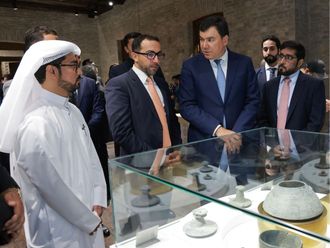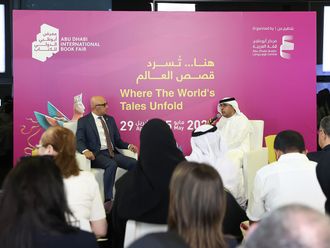Archaeological excavations near Abu Dhabi International Airport have yielded new information on human habitation at the site during the Late Stone Age or Neolithic period 8,000 to 5,000 years ago, the Abu Dhabi Islands Archaeological Survey (ADIAS) said Saturday.
The excavation at the site, which lies within the boundary of the Al Ghazal Golf Club managed by Abu Dhabi Duty Free, was supported by the Duty Free and the Abu Dhabi Department of Civil Aviation.
According to Dr Heiko Kallweit of the University of Freiburg, Germany, and Field Director of ADIAS, several hundred archaeological finds, including pieces of flint and fragments of pottery, were collected during the two-week fieldwork on the site, which ended last week.
The pottery dates back to the early Bronze Age, while the flint materials belong to the Late Stone Age or Neolithic period, preceding the Bronze Age.
"Our first season of fieldwork on the site, in the summer of 1996, revealed the significance of the area. We knew it had been inhabited during four periods, the Late Stone Age or Arabian Neolithic, then two periods in the Bronze Age, the Hafit period, around 3000 BC, and the Umm Al Nar period, from around 2500 BC to 2000 BC, and finally around 2,000 years ago," Dr Kallweit said.
"Our latest fieldwork has produced two important results. First, a detailed study of the entire Al Ghazal Golf Course has shown that habitation in the late Stone Age covered a much larger area than had previously been recognised. In terms of size, this one is one of the largest Late Stone Age sites in the UAE."
Dr Kallweit added the second major discovery was a number of stone tools known as "micro-liths", probably used to form the blades of sickles used for cutting wild grasses or possibly crops.
"Such microliths have never previously been discovered in the emirates, though they were found elsewhere in the peninsula such as western Saudi Arabia near the Red Sea coast."
The Saudi Arabian microliths date back to between 3500 BC and 4000 BC, a period about which very little is known in the emirates. "These finds may help us to begin to understand this period in UAE history," he said.
Besides support from the Al Ghazal Golf Club, Abu Dhabi Duty Free and the Department of Civil Aviation, ADIAS also received help from several other organisations. Local contracting firm Hilalco lent equipment and surveyors to prepare a detailed map of the site, permitting the precise location of each find to be recorded. A group of volunteers from the Emirates Natural History Group worked on the site daily. The group also contributed towards financing part of the work.
Other members of the ADIAS team included local staff members such as Dr Mark Beech and Ingrid Barcelo, Mohammed Hassan, a UAE postgraduate student studying archaeology on an ADIAS grant in the University of York, and Sarah Wood from the University of East Anglia.
Commenting on the importance of the site, Peter Hellyer, ADIAS' Executive Director, said: "Our second season at the airport's archaeological site has been a great success. This has been possible only because of the support we received from the Golf Club, Duty Free and the Department of Civil Aviation. We are particularly grateful to Sheikh Hamdan bin Mubarak Al Nahyan, Chairman of the Civil Aviation Department, who has consistently supported our work at the airport over the years."
"At a technical level, the mapping done by Hilalco was of enormous help, while the fieldwork itself could not be carried out without the support of the Emirates Natural History Group and its members who volunteered to come and help," he added.
First Stone Age flints found in Abu Dhabi
First Stone Age flints found in Abu Dhabi












